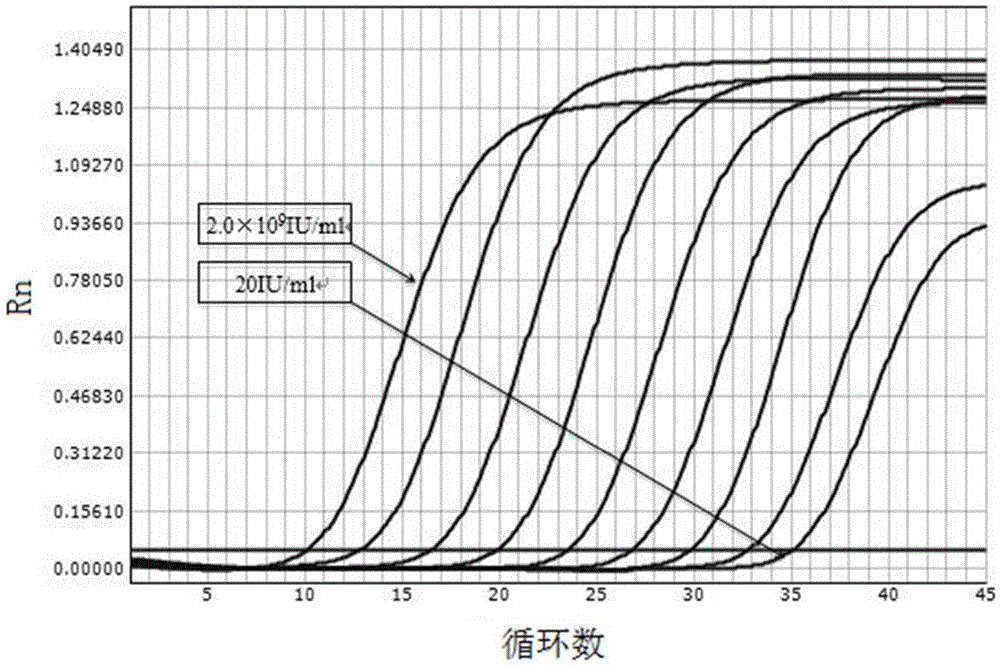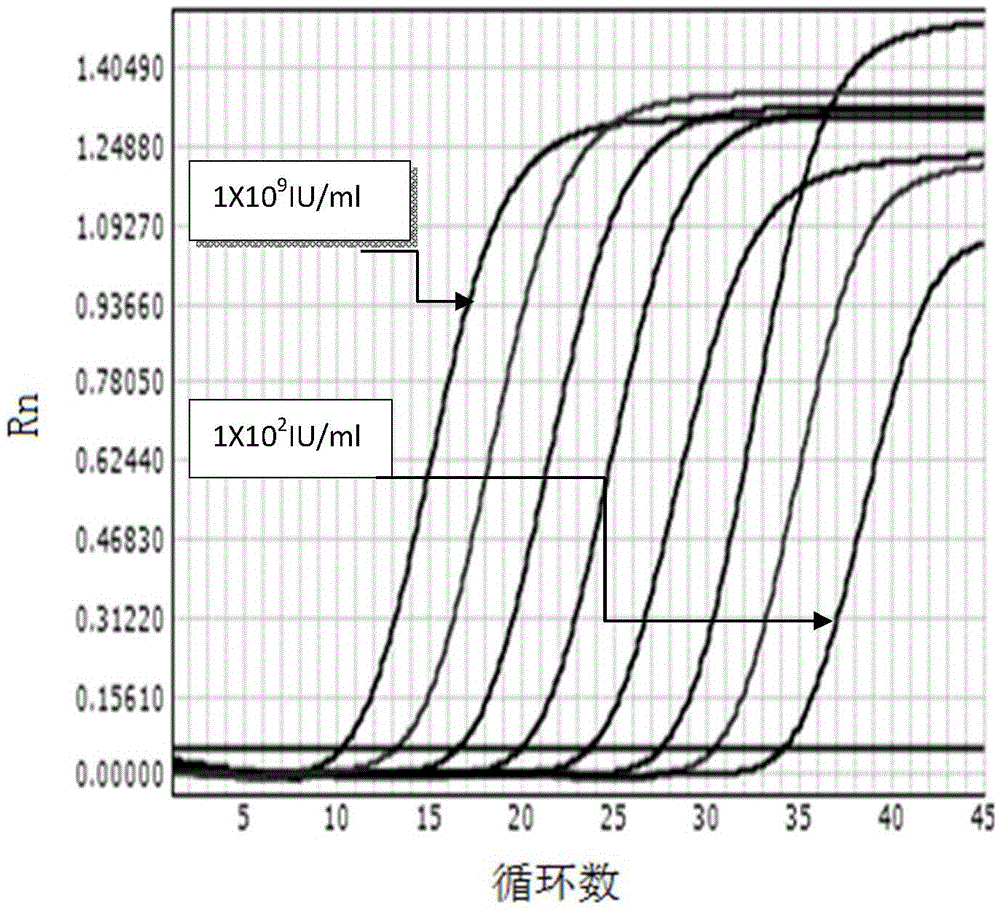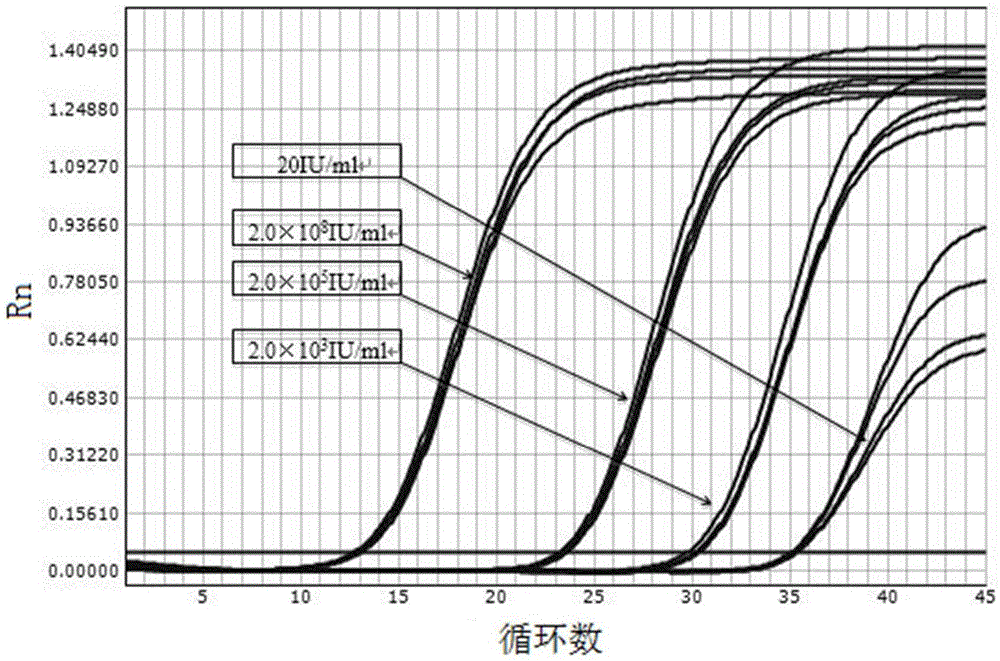Direct real-time quantitative fluorescent PCR method of layered packaging tape indicator
A real-time quantitative fluorescence and indicator technology, applied in the field of molecular biology, can solve the problems of easy pollution, low PCR sensitivity, and complicated nucleic acid extraction operations, and achieve the effect of simple operation and high detection sensitivity.
- Summary
- Abstract
- Description
- Claims
- Application Information
AI Technical Summary
Problems solved by technology
Method used
Image
Examples
Embodiment 1
[0047] Embodiment 1: Real-time quantitative fluorescent PCR detection to HBVDNA
[0048] 1. Coating of hot start DNA polymerase:
[0049] Take 1 μL (2.5-3.5U / μL) of hot-start DNA polymerase, and coat the bottom of the PCR amplification tube with 10-15 μL of paraffin oil mixture with a melting point of 50°C-55°C through melting and condensation.
[0050] 2. Preparation of fluorescent PCR amplification reaction solution:
[0051] The concentration is 40nmol / μL upstream and downstream primers and 30nmol / μL probe; 20nmol / μL Tris base; 20mmol / μL magnesium chloride; 150mmol / μL potassium chloride, 200umol / μL dNTP and no more than 0.001wt% stone green indicator reagents to prepare fluorescent PCR amplification reaction solution.
[0052] 3. Coating of fluorescent PCR amplification reaction solution:
[0053] Dispense 27 μL of the fluorescent PCR amplification reagent to the bottom of the PCR amplification tube in step 1, and add 25 μl of solid paraffin oil with a melting point of 4...
Embodiment 2
[0062] Embodiment 2: Real-time quantitative fluorescent PCR detection to HBVDNA
[0063] 1. Coating of hot start DNA polymerase:
[0064] Take 1 μL of 1.5U / μL hot-start Taq DNA polymerase, and coat the bottom of the PCR amplification tube with 10-15 μL of paraffin oil mixture with a melting point of 50°C-55°C through melting and condensation.
[0065] 2. Preparation of fluorescent PCR amplification reaction solution:
[0066] Each 1 μL concentration is 20 μmol / L upstream and downstream primers and 1 μL 10 μmol / L probe; 20 nmol / μL Tris base; 4 μl 25 mmol / L magnesium chloride; 2 μL 500 mmol / L potassium chloride, 1 μL each 10 mmol / L dNTP and no more than 0.001 wt% The stone green indicator was used to prepare the fluorescent PCR amplification reaction solution.
[0067] 3. Coating of fluorescent PCR amplification reaction solution:
[0068] Dispense 20 μL of the fluorescent PCR amplification reagent to the bottom of the PCR amplification tube in step 1, and add 30 μL of solid ...
Embodiment 3
[0077] Embodiment 3: to the real-time quantitative fluorescent PCR detection repeatability test of HBVDNA
[0078] In addition to using the clinical HBVDNA quantitative detection value of 2.0×10 3 IU / ml, 2.0×10 5 IU / ml and 2.0×10 8 Except the hepatitis B patient's serum of IU / ml, utilize the method identical with embodiment 1 to carry out real-time quantitative fluorescent PCR detection. At the same time, a comparative test was carried out with a commercial kit, and the commercial reagent was the Roche COBAS automatic nucleic acid detection system. Experimental results such as image 3 As shown in Table 1, the results show that the detection repeatability CV% value of the method of the present invention is basically the same as that of commercial Roche COBAS reagents.
[0079] The repeatability contrast of table 1 inventive method and Roche COBAS reagent
[0080]
PUM
| Property | Measurement | Unit |
|---|---|---|
| melting point | aaaaa | aaaaa |
| melting point | aaaaa | aaaaa |
| melting point | aaaaa | aaaaa |
Abstract
Description
Claims
Application Information
 Login to View More
Login to View More - R&D
- Intellectual Property
- Life Sciences
- Materials
- Tech Scout
- Unparalleled Data Quality
- Higher Quality Content
- 60% Fewer Hallucinations
Browse by: Latest US Patents, China's latest patents, Technical Efficacy Thesaurus, Application Domain, Technology Topic, Popular Technical Reports.
© 2025 PatSnap. All rights reserved.Legal|Privacy policy|Modern Slavery Act Transparency Statement|Sitemap|About US| Contact US: help@patsnap.com



